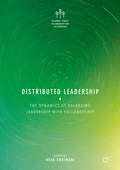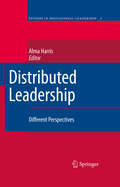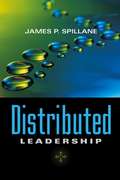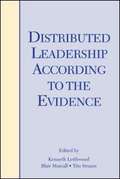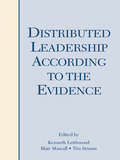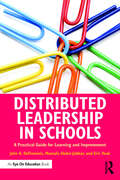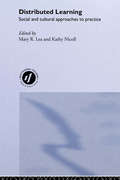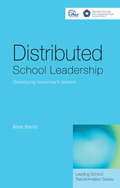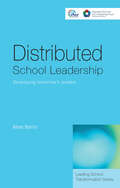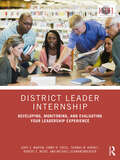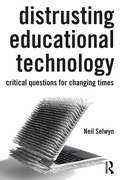- Table View
- List View
Distributed Leadership: The Dynamics of Balancing Leadership with Followership
by Neha ChatwaniAddressing the area of shared leadership, also known as collective or distributed leadership, this edited book embraces the underlying idea that leadership is a dynamic process that intersects closely with followership. While some authors present rigorously researched qualitative and quantitative case studies that investigate the dynamics of followership in distributive leadership in terms of collective decision-making, leadership identity, roles and demographic composition of groups in a variety of settings, other authors take a critical look at distributed leadership models by viewing them through the lens of nature and ecosystems as well as human development processes. The chapters aim to inspire readers to challenge the current definition of leadership and explore more inclusive and holistic paradigms. Distributed Leadership provides a comprehensive and constructive contribution to the field of leadership and will be an essential read for academics and scholar-practitioners interested in business management.
Distributed Leadership: Different Perspectives (Studies in Educational Leadership #7)
by Alma HarrisAlma Harris The ?eld of school leadership is currently preoccupied with the idea of distributed leadership. Few ideas, it seems, have provoked as much attention, debate and c- troversy. Whatever your position on distributed leadership, and you cannot fail to have one, it is irrefutable that distributed leadership has become the leadership idea of the moment. Yet, it is an idea that can be traced back as far as the mid 20s and possibly earlier. So why the interest? Part of the answer can be found in a move away from theorizing and empirical enquiry focused on the single leader. This shift has undoubtedly been fuelled by structural changes, within schools and across school systems that have resulted in - ternative models or forms of leadership practice. Evidence highlights how those - cupying formal leadership positions are increasingly recognizing the limitations of existing structural arrangements to secure organizational growth and transformation (Fullan et al. , 2007; Harris et al. , 2008; Chapman et al. , 2008). As a consequence, many heads and principals are actively restructuring, realigning and redesigning leadership practice in their school (Harris, 2008). While the terminology to describe such changes varies, the core principle is one of extending or sharing leadership practice. While scholars have long argued for the need to move beyond those at the top of organizations in order to examine leadership (Barnard, 1968; Katz and Kahn, 1966) until relatively recently, much of the school leadership literature has tended tofocusupontheheadortheprincipal.
Distributed Leadership (Jossey-Bass Leadership Library in Education #4)
by James P. SpillaneJames Spillane, the leading expert in Distributed Leadership, shows how leadership happens in everyday practices in schools, through formal routines and informal interactions. He examines the distribution of leadership among administrators, specialists, and teachers in the school, and explains the ways in which leadership practice is stretched over leaders, followers, and aspects of the situation, including routines and tools of various sorts in the organization such as memos, scheduling procedures, and evaluation protocols. This book is a volume in the Jossey-Bass Leadership Library in Education—a series designed to meet the demand for new ideas and insights about leadership in schools.
Distributed Leadership According To The Evidence
by Kenneth Leithwood Blair Mascall Tiiu StraussAlthough not new, the concept of distributed (shared) leadership has re-emerged in recent years as one highly promising response to the complex challenges currently faced by schools. Responding productively to these challenges far exceeds the capacities of any individual leader. If schools are to flourish in the future, they will need to enlist the collective expertise of many more of their members and stakeholders than they have in the past. The purpose of this volume is to both present and synthesize the best available evidence about the nature, causes, and effects of distributed school leadership. The book also clarifies common misunderstandings about distributed leadership and identifies promising implications for practice and for future research. Key features include. . . Expertise - Written by the most active and widely respected scholars engaged in research on distributed leadership, the book encompasses the very latest knowledge about the nature, causes and consequences of such leadership in schools. Comparative Models - The book compares various approaches to distributed leadership and examines the conditions under which some approaches may be better than others in improving schools. Evidence-Based - Much of the popularity of distributed leadership is rooted in expectations unsupported by systematic empirical evidence. Virtually all of the available evidence about distributed approach to leadership can be found in this book. This book is appropriate for researchers studying school leadership, instructors and students in graduate-level school leadership courses and practicing administrators at the district and building level. 9780805864229 9781410618573
Distributed Leadership According to the Evidence
by Kenneth Leithwood Blair Mascall Tiiu StraussAlthough not new, the concept of distributed (shared) leadership has re-emerged in recent years as one highly promising response to the complex challenges currently faced by schools. Responding productively to these challenges far exceeds the capacities of any individual leader. If schools are to flourish in the future, they will need to enlist the collective expertise of many more of their members and stakeholders than they have in the past. The purpose of this volume is to both present and synthesize the best available evidence about the nature, causes, and effects of distributed school leadership. The book also clarifies common misunderstandings about distributed leadership and identifies promising implications for practice and for future research. Key features include… Expertise – Written by the most active and widely respected scholars engaged in research on distributed leadership, the book encompasses the very latest knowledge about the nature, causes and consequences of such leadership in schools. Comparative Models – The book compares various approaches to distributed leadership and examines the conditions under which some approaches may be better than others in improving schools. Evidence-Based – Much of the popularity of distributed leadership is rooted in expectations unsupported by systematic empirical evidence. Virtually all of the available evidence about distributed approach to leadership can be found in this book. This book is appropriate for researchers studying school leadership, instructors and students in graduate-level school leadership courses and practicing administrators at the district and building level.
Distributed Leadership According to the Evidence
by Kenneth Leithwood Blair Mascall Tiiu StraussAlthough not new, the concept of distributed (shared) leadership has re-emerged in recent years as one highly promising response to the complex challenges currently faced by schools. Responding productively to these challenges far exceeds the capacities of any individual leader. If schools are to flourish in the future, they will need to enlist the collective expertise of many more of their members and stakeholders than they have in the past. The purpose of this volume is to both present and synthesize the best available evidence about the nature, causes, and effects of distributed school leadership. The book also clarifies common misunderstandings about distributed leadership and identifies promising implications for practice and for future research. Key features include… Expertise – Written by the most active and widely respected scholars engaged in research on distributed leadership, the book encompasses the very latest knowledge about the nature, causes and consequences of such leadership in schools. Comparative Models – The book compares various approaches to distributed leadership and examines the conditions under which some approaches may be better than others in improving schools. Evidence-Based – Much of the popularity of distributed leadership is rooted in expectations unsupported by systematic empirical evidence. Virtually all of the available evidence about distributed approach to leadership can be found in this book. This book is appropriate for researchers studying school leadership, instructors and students in graduate-level school leadership courses and practicing administrators at the district and building level.
Distributed Leadership According to the Evidence (PDF)
by Kenneth Leithwood Blair Mascall Tiiu StraussAlthough not new, the concept of distributed (shared) leadership has re-emerged in recent years as one highly promising response to the complex challenges currently faced by schools. Responding productively to these challenges far exceeds the capacities of any individual leader. If schools are to flourish in the future, they will need to enlist the collective expertise of many more of their members and stakeholders than they have in the past. The purpose of this volume is to both present and synthesize the best available evidence about the nature, causes, and effects of distributed school leadership. The book also clarifies common misunderstandings about distributed leadership and identifies promising implications for practice and for future research. Key features include. . . Expertise - Written by the most active and widely respected scholars engaged in research on distributed leadership, the book encompasses the very latest knowledge about the nature, causes and consequences of such leadership in schools. Comparative Models - The book compares various approaches to distributed leadership and examines the conditions under which some approaches may be better than others in improving schools. Evidence-Based - Much of the popularity of distributed leadership is rooted in expectations unsupported by systematic empirical evidence. Virtually all of the available evidence about distributed approach to leadership can be found in this book. This book is appropriate for researchers studying school leadership, instructors and students in graduate-level school leadership courses and practicing administrators at the district and building level. 9780805864229 9781410618573
Distributed Leadership in Schools: A Practical Guide for Learning and Improvement
by John A. DeFlaminis Mustafa Abdul-Jabbar Eric YoakBuilding on best practices and lessons learned, Distributed Leadership in Schools shows educators how to design and implement distributed leadership to effectively address challenges in their schools. Grounded in case studies and full of practical tools, this book lays out a framework for building strategic, collaborative, and instructionally-focused teams. Supported by voices of practitioners and based upon original research, this comprehensive resource shares concrete strategies, tips, and tools for creating teams that are skilled at using data to plan and monitor their work, and successful in facilitating change to improve student learning. This innovative method will aid leader development and facilitate reflection, and will reshape leadership practice in a way that benefits teachers, leaders, schools, and students.
Distributed Leadership in Schools: A Practical Guide for Learning and Improvement
by John A. DeFlaminis Mustafa Abdul-Jabbar Eric YoakBuilding on best practices and lessons learned, Distributed Leadership in Schools shows educators how to design and implement distributed leadership to effectively address challenges in their schools. Grounded in case studies and full of practical tools, this book lays out a framework for building strategic, collaborative, and instructionally-focused teams. Supported by voices of practitioners and based upon original research, this comprehensive resource shares concrete strategies, tips, and tools for creating teams that are skilled at using data to plan and monitor their work, and successful in facilitating change to improve student learning. This innovative method will aid leader development and facilitate reflection, and will reshape leadership practice in a way that benefits teachers, leaders, schools, and students.
Distributed Learning: Social and Cultural Approaches to Practice
by Mary R. Lea Kathy NicollAt a time of increasing globalisation, the concept of open and distance learning is being constantly redefined. New technologies have opened up new ways of understanding and participating in Learning. Distributed Learning offers a collection of perspectives from a social and cultural practice-based viewpoint, with contributions from leading international authors in the field. Key issues in this comprehensive text are:*the challenges of ICT to traditional teaching and learning practices*the value and relevance of 'activity theory' and 'communities of practice' in educational institutions and the workplace*perspectives on the relationship between globalisation and distributed learning, and the breakdown of distinctions between global and local contexts*issues of identity and community in designing courses for the virtual student*language and literacies in distributed learning contextsThis book provides useful introductory reading, building a sound theoretical framework for practitioners interested in how distributed learning is shaping post-compulsory education.
Distributed Learning: Social and Cultural Approaches to Practice
by Mary R. Lea Kathy NicollAt a time of increasing globalisation, the concept of open and distance learning is being constantly redefined. New technologies have opened up new ways of understanding and participating in Learning. Distributed Learning offers a collection of perspectives from a social and cultural practice-based viewpoint, with contributions from leading international authors in the field. Key issues in this comprehensive text are:*the challenges of ICT to traditional teaching and learning practices*the value and relevance of 'activity theory' and 'communities of practice' in educational institutions and the workplace*perspectives on the relationship between globalisation and distributed learning, and the breakdown of distinctions between global and local contexts*issues of identity and community in designing courses for the virtual student*language and literacies in distributed learning contextsThis book provides useful introductory reading, building a sound theoretical framework for practitioners interested in how distributed learning is shaping post-compulsory education.
Distributed School Leadership: Developing Tomorrow's Leaders (Leading School Transformation)
by Alma HarrisTomorrow’s schools will need new forms of leadership. The old hierarchical models of leadership simply do not fit any longer. We need to develop new leaders at all levels of the system if we are serious about sustaining improvement and change. But, how do we go about this? The book focuses on the why, how and what of distributed leadership by offering a practical insight into what it looks like in schools. It argues that our new system leaders are already in schools and that the main challenge is to develop them and maximise their collective capacity to make a difference. Drawing on the ‘Developing Leaders Programme’, which aimed to develop young leaders in schools, it provides practical examples and case-study evidence of distributed leadership in action. The main aims of the book are to: provide a clear account of more widely distributed leadership offer evidence about its positive impact on organisational and individual learning give case-study exemplars and practical illustrations of how it works in practice. The book also considers the leadership of networks and the new forms of partnership schools are engaged in. It looks at how lateral capacity is built and the part distributed leadership plays in generating leadership capacity between schools. It will be of interest to headteachers, aspiring school leaders, teachers and educational professionals.
Distributed School Leadership: Developing Tomorrow's Leaders (Leading School Transformation)
by Alma HarrisTomorrow’s schools will need new forms of leadership. The old hierarchical models of leadership simply do not fit any longer. We need to develop new leaders at all levels of the system if we are serious about sustaining improvement and change. But, how do we go about this? The book focuses on the why, how and what of distributed leadership by offering a practical insight into what it looks like in schools. It argues that our new system leaders are already in schools and that the main challenge is to develop them and maximise their collective capacity to make a difference. Drawing on the ‘Developing Leaders Programme’, which aimed to develop young leaders in schools, it provides practical examples and case-study evidence of distributed leadership in action. The main aims of the book are to: provide a clear account of more widely distributed leadership offer evidence about its positive impact on organisational and individual learning give case-study exemplars and practical illustrations of how it works in practice. The book also considers the leadership of networks and the new forms of partnership schools are engaged in. It looks at how lateral capacity is built and the part distributed leadership plays in generating leadership capacity between schools. It will be of interest to headteachers, aspiring school leaders, teachers and educational professionals.
The Distributed University for Sustainable Higher Education (SpringerBriefs in Education)
by Richard Frederick HellerThis book is open access and discusses the re-imagining of the higher education sector. It exposes problems that relate to the way that universities have become over-managed business enterprises which may not reflect societal, national, or global educational needs. From there, it proposes some solutions, including three innovative programs, that make universities more responsive to needs, as well as reduce their impact on the environment. The central idea of this book is developing the ‘Distributed University,’ which distributes education to where it is needed, reducing local and global inequalities in access, and emphasizing local relevance in place of large centralized campuses, with a low impact on the environment. It emphasizes the distribution of trust in place of managerialism and collaboration in place of competition. By focusing on distributing education online, this book discusses how the higher education sector can be set up to adapt to the changes in the ways we work and learn today, and which will be required to adapt to and take advantage of the Fourth Industrial Revolution.
District Leader Internship: Developing, Monitoring, and Evaluating Your Leadership Experience
by Gary E. Martin Jimmy R. Creel Thomas W. Harvey Robert E. Nicks Michael SchwanenbergerDistrict Leader Internship challenges school district leader interns to develop a rigorous and broad-based experience to prepare for their first job as a superintendent. This text provides step-by-step guidance for interns, district supervisors, and preparation program faculty to develop, monitor, and evaluate the internship experience. This accessible resource includes activities and assessments, explores how to develop an internship plan, unpacks duties of the intern, supervisor, and advisor, and helps readers prepare a final program report. The content is aligned with the National Education Leadership Preparation (NELP) Standards for district-level administrators and assists in preparation for certification exams and applications for desired superintendency positions.
District Leader Internship: Developing, Monitoring, and Evaluating Your Leadership Experience
by Gary E. Martin Jimmy R. Creel Thomas W. Harvey Robert E. Nicks Michael SchwanenbergerDistrict Leader Internship challenges school district leader interns to develop a rigorous and broad-based experience to prepare for their first job as a superintendent. This text provides step-by-step guidance for interns, district supervisors, and preparation program faculty to develop, monitor, and evaluate the internship experience. This accessible resource includes activities and assessments, explores how to develop an internship plan, unpacks duties of the intern, supervisor, and advisor, and helps readers prepare a final program report. The content is aligned with the National Education Leadership Preparation (NELP) Standards for district-level administrators and assists in preparation for certification exams and applications for desired superintendency positions.
Distrusting Educational Technology: Critical Questions for Changing Times
by Neil SelwynDistrusting Educational Technology critically explores the optimistic consensus that has arisen around the use of digital technology in education. Drawing on a variety of theoretical and empirical perspectives, this book shows how apparently neutral forms of educational technology have actually served to align educational provision and practices with neo-liberal values, thereby eroding the nature of education as a public good and moving it instead toward the individualistic tendencies of twenty-first century capitalism. Following a wide-ranging interrogation of the ideological dimensions of educational technology, this book examines in detail specific types of digital technology in use in education today, including virtual education, ‘open’ courses, digital games, and social media. It then concludes with specific recommendations for fairer forms of educational technology. An ideal read for anyone interested in the fast-changing nature of contemporary education, Distrusting Educational Technology comprises an ambitious and much-needed critique.
Distrusting Educational Technology: Critical Questions for Changing Times
by Neil SelwynDistrusting Educational Technology critically explores the optimistic consensus that has arisen around the use of digital technology in education. Drawing on a variety of theoretical and empirical perspectives, this book shows how apparently neutral forms of educational technology have actually served to align educational provision and practices with neo-liberal values, thereby eroding the nature of education as a public good and moving it instead toward the individualistic tendencies of twenty-first century capitalism. Following a wide-ranging interrogation of the ideological dimensions of educational technology, this book examines in detail specific types of digital technology in use in education today, including virtual education, ‘open’ courses, digital games, and social media. It then concludes with specific recommendations for fairer forms of educational technology. An ideal read for anyone interested in the fast-changing nature of contemporary education, Distrusting Educational Technology comprises an ambitious and much-needed critique.
Disturbing Pleasures: Learning Popular Culture
by Henry A. GirouxIn Disturbing Pleasures Henry Giroux demonstrates how his well-known theories of education, critical pedagogy and popular culture can be put to use in the classroom and in other cultural settings. Adding an entirely new dimension to his thinking about the cultural sites at which pedagogical practice takes place, Giroux illustrates how professors, school teachers and other cultural workers can appropriate what he refers to as a "pedagogy of cultural studies."
Disturbing Pleasures: Learning Popular Culture
by Henry A. GirouxIn Disturbing Pleasures Henry Giroux demonstrates how his well-known theories of education, critical pedagogy and popular culture can be put to use in the classroom and in other cultural settings. Adding an entirely new dimension to his thinking about the cultural sites at which pedagogical practice takes place, Giroux illustrates how professors, school teachers and other cultural workers can appropriate what he refers to as a "pedagogy of cultural studies."
Disziplin oder Profession: Was ist Schulpädagogik?
by Martin RothlandDas Buch liefert eine umfassende Auseinandersetzung mit der Schulpädagogik als Subdisziplin der Erziehungswissenschaft. Wie in neueren und neuesten schulpädagogischen Selbstbeschreibungen die kognitive Spezifität der Schulpädagogik als wissenschaftliche (Teil-)Disziplin der Erziehungswissenschaft sowie ihr Verhältnis zur Schulpraxis artikuliert wird, ist Gegenstand der Beschreibung und Reflexion in diesem Band.Vor dem Hintergrund einer im Ergebnis unbefriedigenden Suche nach ihrem eigenständigen Erkenntnisinteresse wird der Versuch unternommen, die kognitive Spezifität der Schulpädagogik am Beispiel der Allgemeinen Didaktik im Zusammenwirken mit der empirisch-quantitativen Unterrichtsforschung zu beschreiben, um exemplarisch eine genuin schuldpädagogische Forschungsperspektive zu eröffnen.
Disziplin und Leistung im Alltag einer zweiten Grundschulklasse: Eine ethnographische Studie (Studien zur Schul- und Bildungsforschung #81)
by Annette HessWas geschieht in einer Grundschulinklusionsklasse beim Übergang zu den ersten benoteten Klassenarbeiten? Was geschieht, wenn Disziplin und Leistung als implizite kulturelle Codes von Leistungsbeurteilung in den Alltag von Zweitklässlern eintreten? Annette Hess beschreibt die Beobachtungen einer Unterrichtsteilnahme im Schuljahr 2015/2016 und analysiert sie in subjektivierungstheoretischer Perspektive. Empirische Beispiele zeigen die subjektiven und situationsspezifischen Faktoren auf, die den Schwierigkeitsgrad von Klassenarbeiten und die Notengebung bestimmen. Die Studie gewährt Einblicke in Prozesse, in deren Verlauf die Schüler*innen beginnen, das hierarchisierende Notensystem in der Realität ihrer sozialen Beziehungen hervorzubringen. Situationsbeschreibungen geben Aufschluss über die schwierige paradoxe Situation der Lehrkräfte zwischen Inklusion und rangordnender Leistungsbeurteilung. Eine Genealogie heutiger schulischer Leistungsbeurteilung im Anschluss an Überwachen und Strafen (Foucault 1976) verlegt deren kulturhistorische Wurzeln in ein Disziplinensystem des frühen europäischen Bürgertums.
Disziplinschwierigkeiten in der Schule: Eine qualitative Einzelfallstudie mit einem gruppen- und bindungstheoretischen Schwerpunkt
by Cornelia HoffmannDivaswapn: દિવાસ્વપ્ન
by ગીજુભાઈ બધેકાદિવાસ્વપ્ન પુસ્તક ૩ ખંડ માં લખાયેલ છે પ્રથમ ખંડ માં ૧૦ પ્રકરણ છે.દ્વિતીય ખંડ માં ૭ પ્રકરણ છે . તૃતીય ખંડ માં ૯ પ્રકરણ આપેલ છે અને અંત માં સન્માનથેલી અર્પણ સમારંભ પ્રસંગે આપેલા ભાષણમાંથી લીધેલ પ્રશંગ રજુ કરવા માં આવેલ છે .
Dive, Dolphin!: Level 1 (PDF)
by Shira Evans National Geographic Kids StaffNational Geographic Primary Readers pair magnificent National Geographic photographs with engaging text by skilled authors to help your child learn to read. Developed by education experts, this series of books for beginner readers is spread across four levels: Early Reader, Becoming Fluent, Becoming Independent and Independent Reader. From the playful bottlenose dolphin to the powerful orca, young readers will learn all about these amazing animals in this National Geographic Level 1 book. Told in simple yet lively text, Dive, Dolphin! will enchant kids who are just beginning their reading journey. Level 1: Early Reader books contain simple sentences and are just right for children who can decode with ease and are beginning to read fluently. They are ideal for readers of Yellow and Blue book bands for guided reading.
